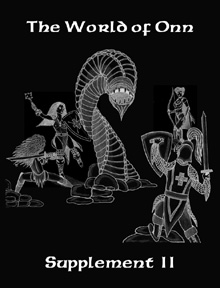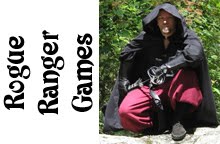In the last post, small changes to how healing worked were introduced into the current system of Onn and in general any retro- or oldschool-style game. I say small, but also far reaching due to the fact that hit points are a central part of the game, as is their loss and recovery.
Damage and Death is the way hit points are lost (obviously). Individual Referees may desire to come up with systems of their own to simulate the declining health of an adventurer as they lose hit points, but for the scope of Onn, the fact they are getting so close to death is enough for this one.
If a character is reduced to 0 hit points exactly, he is unconscious but stable. If left alone long enough, the character may recover or die on his own (Referees are free to adjucate this to what best fits their game).
Under 0 hit points, a character is considered dying from internal and/or external damage. Each round the character rolls a Toughness saving throw with his negative hit point total applied as a penalty to the roll. If he fails the roll he takes an additional point of damage; suceeding the roll places him stable at 0 hit points.
Characters reaching a negative hit point total equal to their maximum 1st level hit points are dead.
If a character heals naturally or is magically healed back to positive hit points, he suffers a -4 penalty to all die rolls until he has a full day of rest.
Natural Healing is the most often neglected recovery method of hit points. In worlds where magical healing is available, natural recovery is often moot or all but forgotten. Characters regain their Constitution's Natural Healing rate for each day of rest. Rest is considered non-stressful activity (equipment upkeep, foraging, small game hunting, sitting around or praying/studying, etc) no matter where the character is. Adventurers don't need a warm bed and cushy settings to be considered resting (though of course it is the most preferred!).
Now, if a character spends 2 weeks in a civilized location and comfortable while under the care of another tending to him, he regains full hit points at the end of the 2 week period regardless of how hurt he is.
Fast Healing is a weaker form of regeneration (that all-too-familiar property of Trolls). Characters with Fast Healing heal the indicated rate regardless of their activity level until they reach 0 hit points...at that point the body is too damaged to continue to repair itself.
Magical Healing is the most common form of healing adventurers encounter. The 4 healing spells Clerics, Druids, Divine Champions and Rangers have access to in the World of Onn would look like so:
Damage and Death is the way hit points are lost (obviously). Individual Referees may desire to come up with systems of their own to simulate the declining health of an adventurer as they lose hit points, but for the scope of Onn, the fact they are getting so close to death is enough for this one.
If a character is reduced to 0 hit points exactly, he is unconscious but stable. If left alone long enough, the character may recover or die on his own (Referees are free to adjucate this to what best fits their game).
Under 0 hit points, a character is considered dying from internal and/or external damage. Each round the character rolls a Toughness saving throw with his negative hit point total applied as a penalty to the roll. If he fails the roll he takes an additional point of damage; suceeding the roll places him stable at 0 hit points.
Characters reaching a negative hit point total equal to their maximum 1st level hit points are dead.
If a character heals naturally or is magically healed back to positive hit points, he suffers a -4 penalty to all die rolls until he has a full day of rest.
Natural Healing is the most often neglected recovery method of hit points. In worlds where magical healing is available, natural recovery is often moot or all but forgotten. Characters regain their Constitution's Natural Healing rate for each day of rest. Rest is considered non-stressful activity (equipment upkeep, foraging, small game hunting, sitting around or praying/studying, etc) no matter where the character is. Adventurers don't need a warm bed and cushy settings to be considered resting (though of course it is the most preferred!).
Now, if a character spends 2 weeks in a civilized location and comfortable while under the care of another tending to him, he regains full hit points at the end of the 2 week period regardless of how hurt he is.
Fast Healing is a weaker form of regeneration (that all-too-familiar property of Trolls). Characters with Fast Healing heal the indicated rate regardless of their activity level until they reach 0 hit points...at that point the body is too damaged to continue to repair itself.
Magical Healing is the most common form of healing adventurers encounter. The 4 healing spells Clerics, Druids, Divine Champions and Rangers have access to in the World of Onn would look like so:
Cure Light Wounds*
Spell Level:
Cleric/Druid, 1st Level
Range: Touch
Duration: Instant
Immediately cures wounds on the target equal to 1 point, plus the target's natural healing rate. Optionally, this spell
can remove paralysis but when cast in this fashion no damage is cured.
An evil reversal of
this spell allows an Anti-cleric to cause light wounds for 1+1d6 damage if he
successfully strikes the victim with a +2 bonus on the ‘to-hit’ roll.
Cure Serious Wounds*
Spell Level:
Cleric/Druid, 4th Level
Range: Touch
Duration: Instant
Immediately cures wounds on the target
equal to 4 points, plus double the dice of the target’s natural healing rate. Optionally, this
spell can remove paralysis, cure blindness or deafness but when cast in one of
these fashions no damage is cured.
An evil reversal of
this spell allows an Anti-cleric to cause 4+2d6 points of damage if he
successfully strikes the victim with a +2 bonus on the ‘to-hit’ roll.
Healing Circle*
Spell Level: Cleric/Druid, 5th Level
Range: Self
Duration:
Instantaneous
This spell
heals the caster and all allies in a 10 ft radius around the caster of 4 points, plus
double the target’s natural healing rate. Optionally, this spell can remove
paralysis, cure blindness or deafness in an ally at the caster’s desire, but
when these maladies are removed only 1 point, plus the target’s natural healing
rate are cured for that individual.
An evil reversal of
this spell allows an Anti-cleric to cause a circle of wounds inflicting 4+2d6
points of damage to all enemies in a 10 ft radius around the caster.
Cure Critical Wounds*
Spell Level:
Cleric/Druid, 7th Level
Range: Touch
Duration: Instant
Immediately cures wounds on the target
equal to 16 points, plus quadruple the target’s natural healing rate. Optionally,
this spell can remove paralysis, cure blindness or deafness but when cast in
one of these fashions no damage is cured.
An evil reversal of
this spell allows an Anti-cleric to cause 16+4d6 points of damage if he
successfully strikes the victim with a +2 bonus on the ‘to-hit’ roll.




